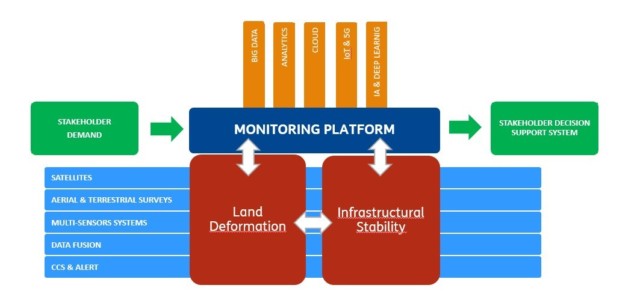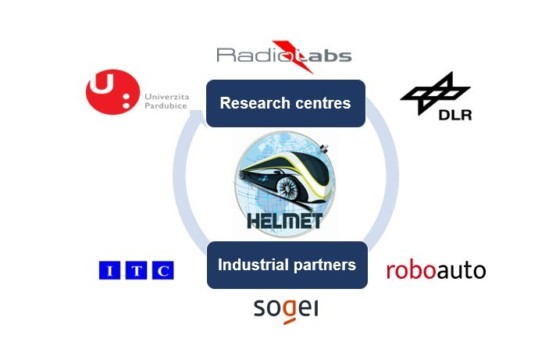Space for Critical Infrastructure – Putting the EC proposal into action

During the previous sessions of Space 4 Critical Infrastructure, the focus was on the scope of the proposed EU Directive on the resilience of critical entities as well as the rationale behind it. The last webinar of the introductory part of the series covered the question on how to put the proposed directive into action. The European Commission shared opportunities and views for the green and digital transition in the construction sector. Furthermore, two examples of cooperative projects in the transport sector were addressed. One national project related to the use of satellite technology for monitoring the stability and security of infrastructure, and one European project on EGNSS applications for mobility solutions.
Circular economy in the construction industry
The construction industry ecosystem currently contributes almost 10% of EU value added , and employs around 25 million people in over 5 million firms. As the biggest single source of waste in the EU (35.9% of and with construction activity accounting for half of Europe’s extracted resources, it also has a significant environmental impact.
Philippe Moseley, Policy Officer at the Construction Unit in the Directorate General in the Internal Market, Industry, Entrepreneurship, and SMEs (DG GROW), presented policies of the green and digital transition in the construction sector. The European Commission is working on a transition pathway in partnership with business and industry, public authorities, and other stakeholders to modernise the industry and improve productivity, while at the same time reducing the environmental impact. In a resource-intensive sector such as construction, circularity is all the more important. Circularity in construction translates in different actions such as preventing and reducing waste, recovering materials, extending the life cycle of materials, energy efficiency, and sustainable urban planning. The Circular Economy Principles for Buildings Design sets out a guidance by gathering case studies and policy recommendations for the circular economy in buildings.
As demonstrated throughout this webinar series, space assets can be part of this transition. For example, in the event of a natural disaster Earth observation can support reconstruction efforts. Furthermore, ground movement of millimeters can be detected over wide areas with satellite radar data, helping authorities to evaluate the effects of a disaster on the land surface stability. Satellite imagery can also help to monitor the status and extend the life of critical infrastructure, detect illegal building sprawl, monitor the stability and structural integrity of infrastructure, empower local residents to safeguard green and blue open spaces, green buildings services such as optimising energy consumption, urban planning, etc.
In order to reach the Green Deal targets, there are several initiatives and funding programmes relevant for construction. The Big buyers initiative brings together public purchasers such as cities and national infrastructure procurement bodies to exchange best practices and marketing intelligence, and joint marketing engagement offering guidance and the latest information about technological developments. The NextGenerationEU offers the Recovery and Resilience Facility to raise funds to help EU Member States implement reforms and investments preparing for the green and digital transitions. The Horizon Europe Cluster 4 features the section “A New Way to Build” with topics on digital logbooks, digital permits and compliance checks, and in Cluster 5 there is the Public Private Partnership called “Built for people” looking at the whole value chain of construction to accelerate deployment of solutions for a sustainable built environment.
Monitoring transport infrastructure
Moving on from the construction sector to transport infrastructure, Raffaele Santangelo, Deputy Program Manager of Enterprises Network presented “Mille Infrastrutture”. The predecessor of the proposed directive, the European Critical Infrastructure (ECI) Directive of 2008 already applied to the energy and transport sectors, designating road and rail networks as European critical infrastructures. However, as covered in the previous session, the collapse of the Morandi Bridge in Genoa highlighted the need to intervene on the methods and effectiveness of infrastructure monitoring systems.
To this end, the Italian Ministry of Infrastructure and Transport updated the guidelines for risk classification and management, safety assessment and monitoring of existing bridges of highways. With the realisation of an open digital database for works with a high alert level, it aims to achieve full infrastructure digitisation.
In July 2021, the “Mille Infrastruttere” enterprises network was established to aggregate the best national excellences in the sector the skills to apply complex digital models (digital twin, decision support tools, automatic detection of anomalies, etc.). It is aimed to provide decision-making support and to interoperate with other platforms of public bodies, increasing the effectiveness of monitoring while reducing costs and implementation times. The network is implementing a monitoring platform combining different datasets and technologies (satellites, drones, AI, terrestrial surveys, etc.) to ensure the protection of national critical infrastructures.

GNSS infrastructure for automotive, rail, and drones
To conclude the session, Arianna Persia, researcher at Radiolabs, brought us back to the European level with the High Integrity EGNSS Layer for Multimodal Eco-friendly Tranportation (HELMET) H2020 Project. The project consortium, consisting of research centres and industrial partners, aims to develop a cyber-secured multimodal, multi-sensor integrity monitoring architecture based on EGNSS in three different transportation sectors: automotive, rail, and drones.

The transport sector is rapidly changing, moving towards increasingly safe and sustainable mobility. Satellite navigation technologies are critical for an eco-friendly and smart transport sector that makes the most of digitalisation and automation. Target EGNSS applications within the HELMET Project are connected and driverless cars, train management and automation, as well as drones for the surveillance of roads and railways.
Thematic sessions Space 4 Critical Infrastructure
After three introductory sessions to set the stage on the novelties of the proposed directive, the webinars will now explore operational satellite-based applications per each sector identified in the proposed EU-directive (public administration, energy, transport, banking and financial market infrastructures, drinking water and waste water, digital infrastructure, health, and space).
Watch the full recording here:
